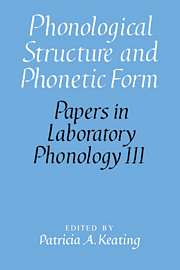Book contents
- Frontmatter
- Contents
- List of contributors
- Acknowledgments
- 1 Introduction
- I Intonation
- II Syllables
- III Feature Theory
- 12 The phonetics and phonology of Semitic pharyngeals
- 13 Possible articulatory bases for the class of guttural consonants
- 14 Phonetic evidence for hierarchies of features
- 15 Do acoustic landmarks constrain the coordination of articulatory events?
- IV Phonetic Output
- Index of subjects
- Index of names
14 - Phonetic evidence for hierarchies of features
Published online by Cambridge University Press: 26 February 2010
- Frontmatter
- Contents
- List of contributors
- Acknowledgments
- 1 Introduction
- I Intonation
- II Syllables
- III Feature Theory
- 12 The phonetics and phonology of Semitic pharyngeals
- 13 Possible articulatory bases for the class of guttural consonants
- 14 Phonetic evidence for hierarchies of features
- 15 Do acoustic landmarks constrain the coordination of articulatory events?
- IV Phonetic Output
- Index of subjects
- Index of names
Summary
Introduction
When one attempts to specify the acoustic and articulatory correlates of distinctive features, one is often frustrated by the apparent many-to-one relations that exist between acoustic or articulatory properties and the abstract features which appear to be a part of a speaker/listener's knowledge of language. One step toward resolving this difficulty is to organize the features into hierarchies similar to those used in current approaches to phonology (Clements 1985; McCarthy 1988). On the basis of acoustic articulatory data, the features can be organized roughly into three classes (Halle and Stevens 1991): (1) articulator-free features that indicate whether a narrow constriction is made in the vocal tract and, if so, whether or not a complete closure is formed and whether pressure is built up behind the constriction; (2) articulator-bound features indicating the primary articulator that is active in forming the constriction (whether it be a narrow consonantal constriction or a less severe vocalic constriction), and specifying further details about the placement of the constriction; and (3) articulatorbound features indicating active adjustments of secondary articulators (i.e. articulators other than the primary ones), such as larynx, the soft palate, and the tongue body (for cases in which the tongue body is not the primary articulator). This hierarchical organization can serve as a basis for ordering the identification of features from the acoustic signal, with the more context-independent features being identified first and the more context-dependent features identified later.
A second proposal that may help to clarify the acoustic and articulatory correlates of the features is to give greater attention to the concept of landmarks in the sound that are produced by implementing articulator-free features.
- Type
- Chapter
- Information
- Phonological Structure and Phonetic Form , pp. 242 - 258Publisher: Cambridge University PressPrint publication year: 1994



